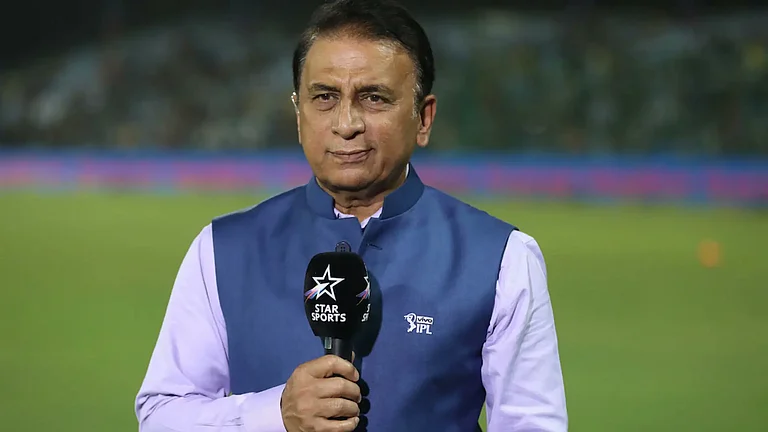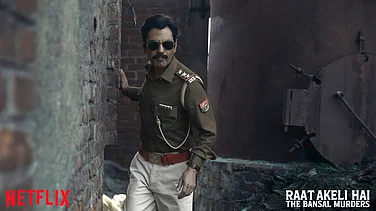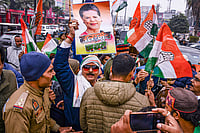A man lies near a gravestone with the picture of the deceased doctor from RG Kar Medical College, Kolkata, allegedly raped and murdered on August 9. Melancholic music plays in the background. A public service announcement (PSA) shows a state police’s SOS feature allowing officials to track someone’s phone [with their permission] and take action if the passenger stops responding to calls, messages. Captioned “Every Woman Should Watch”, the clip, shared by R Madhavan, predictably puts the onus of women’s safety on… women. Twitter accounts and Facebook pages are liberally circulating screenshots of rape-revenge, vigilante films like Simmba (2018) and Maharaja (2024) that echo and endorse the emotionally charged sentiments of our society. Dozens of influencers have uploaded cleverly worded “explainers” on what happened at RG Kar Medical College, each claiming to have “exclusive” facts and some of them reeking of political bias.
Welcome to India’s social media in 2024, where “rape”, “RG Kar medical college” and “Kolkata” are Search Engine Optimisation (SEO) keywords, mining and milking a tragedy. Despite some sincere, nuanced coverage around the incident and its aftermath, there’s enough noise not just adding to the hysteria, but also feeding off of it.
Satshya Tharien, a former-journalist-turned-content-creator, discovered the reel of the man lying near a gravestone with the victim’s face on it, and couldn’t believe her eyes. “It’s so tasteless, ridiculous and dramatic that you don’t understand its purpose. It’s not about the issue but them trying to gain followers from a certain kind of content that will get more engagement.”
Tharien calls it ‘shock entertainment’ – something we also saw when most TV news channels covered Sridevi’s death in 2018. “You remember those re-enactments of how someone could drown in a bathtub? We don’t have to re-enact someone’s last moments; it’s very insensitive.” According to Tharien, when a news channel runs these things, several checks and balances apply to them. Creators should be held to a similar standard. Some might say it’s tricky, seeking regulation for a medium that has democratised public discourse. But it’s also true that many users are irresponsible about their platforms, sharing the most provocative, sensationalist ‘content’ to get traction.

This includes graphic cartoons of the victim depicting her on the morning she was discovered, as per the accounts of family members. Some claim to be tributes, but their inherent crassness suggests the opposite. Author AM Gautam, who's recently published Indian Millennials: Who Are They Really?, explains: “You know how Milan Kundera said that eventually everything turns to kitsch and kitsch is the stopover between being and oblivion? Well, in our times cringe is the stopover between being and virality.”
Filmmaker Devashish Makhija doesn’t recollect any imagery from the last couple of weeks, but what he has found disturbing is how liberally the victim’s identity has been shared. “We’re so used to consuming the aftermath of violence in the news daily. We’ve gotten numb. We’re talking about the victim’s identity in a callous, offhanded way. I think that is the most insensitive thing in such a case.”
While social media has made it easier to discuss social issues, it has also made public discourse much more volatile and immediate. “The democratisation of social media platforms also brings with it desensitisation on a mass level,” says Makhija. “But this medium has protracted the conversation for so long, so it’s definitely worth something—given we tend to forget and move on quickly.”
Gautam, whose book features a collection of essays on Indian millennials (born between 1980 and 1996), contends that generation overestimates the impact of social media on grass roots. Often, an Indian millennial shares an Instagram story or retweets something and feels satisfied with fulfilling their social responsibility. Besides, social media has made it too easy to depict oneself as socially aware and, therefore, made conscientiousness that much easier to fake. It’s what Gautam calls the ‘Millennial Hero Complex’. “It’s a curious kind of naiveté that refuses to learn from precedent. How many visuals from Gaza did we share? Dead kids, razed buildings, bombed hospitals—did anything change? Did we stop the slaughter by sharing ‘all eyes on Rafah’?”
Tharien is less cynical about social media, noting that it works as a platform for self-expression for people in despair. “I can’t go to India Gate because because I have an infant at home. One does want the government to know about their protest, but it’s not like we can personally knock on a politician’s door.” She suggests that since people are now aware that politicians are very active on social media, they hope that internet movements will help lawmakers gauge the public’s anger level about a situation and take action accordingly. “Social media allows a sense of community, especially when you don’t have it in real life.”
There’s another important vertical in pop culture that dictates the quality of public discourse in the aftermath of a high-profile sexual assault case: cinema. Mainstream films have rarely pondered why rapes are so frequent in India, and what pervades the unequal power dynamic between genders. A sub-genre of films in the ’80s like Sherni (1988) and Zakhmi Aurat (1988) – it has persisted and shown only little evolution in the last 40 years. Even grittier films like Bandit Queen (1994) used its rape sequence to convey little beyond shock. Films as recent as Mom (2017), Kaabil (2017), Maharaja (2024) are all guilty of endorsing and popularising the kill the rapist rhetoric.
Makhija’s debut, Ajji (2017), did something along similar lines—something the 45-year-old filmmaker concedes during our conversation. “I’m quite conflicted by it [the ‘message’ of Ajji]. I wanted to lay out the costs incurred in becoming that vigilante. I had no grip on my rage, and it came out in that act [when the protagonist chops off the rapist’s balls]. I don’t know if I stand by it.” He’s audibly uncomfortable with the idea that someone would use an image from the film to galvanise and endorse the society’s frenzied state right now. “I wouldn’t know what to make of it anymore. I’d obviously distance myself from that message. And yet, if an aggrieved woman wants to send that message out, then I don’t have a take on it. After all, I don’t know what it feels like to live with constant dread of being violated daily.” He notes how the exploitation film in Hollywood – popular in the ’70s with dramas like Vanishing Point (1971) and Lipstick (1976) – initially started out as vigilante movies. But some devolved into borderline pornography. He adds, ''I don’t know where a filmmaker’s responsibility ends, and the audience’s begins. It’s obviously a two-way street.”
Gautam believes that the sentiment of ‘kill the rapists’ stems from our need for a quick-fix solution and our decreasing faith in due process. “We want to pay a cost in terms of sharing a viral Insta story and purchasing justice with that five-second effort of ours.” The 30-year-old author also believes there’s a reason the superhero films have flourished across the world in the last decade. “What are superheroes? Literal strongmen who are above the law, doling out quick vigilante ‘justice’, and in whose good intentions the common people are supposed to have unshakeable faith.”
According to Tharien, we should not take the viral Insta posts literally, but instead look at the frustration behind them. “My takeaway is that people (especially women) are angry, and justifiably so. When Nirbhaya happened everybody flooded the streets, new laws were passed; we all thought things would get better. But it feels like nothing has changed.”
As much bad rep influencers get, it’s also important for the public to be more discerning about the content they engage with. Tharien observes that there are many creators good at ‘rage-baiting’, wilfully and unapologetically disseminating misinformation. Whether it’s someone praising them or sharing their reels to point out their problematic bits — it all counts as engagement for the creator. “The biggest punishment you can give to a content creator is indifference. If something irritates you, [then] don’t share or comment. Simply report.” Makhija agrees: “Creators are not operating in a vacuum; they have their ear to the ground. They aren’t fools to make things no one wants to watch.”
It throws up an absorbing question about whether social media algorithms are tools in our hands, or have they become mirrors to project our most invasive, insensitive thoughts? Gautam believes that the platforms are performing their function by keeping us hooked to them and giving us the false sense of being ideological warriors who can trigger revolutions. Makhija says the algorithms are reprogramming our individual subconscious, based on the data of what’s getting more traffic. “We’re getting brainwashed by these algorithms, because they reward crassness and titillation. After a point, we can’t control its grip on us, and it becomes a widespread malaise of bloodlust.”
Having said that, Makhija finds himself jittery painting social media as ‘evil’, especially after having witnessed its impact first-hand, when he organised a donation drive at the start of the pandemic. “Painting social media activism in one broad stroke will mean nullifying Tahrir Square (the Egyptian revolution). It would be incorrect to say it has no impact, but it also makes many well-meaning people complacent too quickly.”



























